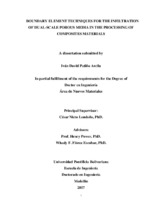| dc.description.abstract | Boundary Element Techniques are implemented in the simulation of the impregnation phenomenon of dual-scale porous media used in the processing of composites materials at both mesoscopic (filling of Representative Unitary Cells) and macroscopic scales (filling of cavities). Three kinds of problems are considered: 1) Simultaneous filling of channels and bundles to study the void formation in Representative Unitary Cells (RUC´s) at constant inlet pressure and constant inlet flow rate regimes, based on the Stokes-Darcy (S-D) and Stokes-Brinkman (S-B) formulations, 2) Filling of bundles considering fully filled channels, based on the Stokes-Darcy formulation, to study the dynamic evolution of voids (compression, motion, migration and splitting), to determine sink functions that account for the partial saturation effects and to analyse the influence of the saturation level on the effective unsaturated permeability, 3) Unidirectional filling of cavities considering the partial saturation effects by means of a lumped strategy, based on an Equivalent Darcy formulation. All numerical codes are validated with classical coupled problems free fluid-porous media and the moving boundary simulations are compared with numerical and experimental results previously reported in the literature. The first kind of problem is tackled in Chapters 3 and 4, where tracking algorithms that generate the exact fluid front shape are developed, as well as a flow-direction dependent model for the capillary pressure. According to the numerical results, the size and shape of the voids are influenced by some processing, material and geometric variables, as well as by the formulation type (S-D and S-B), matching conditions and RUC compaction. On the other hand, Chapter 5 deals with part of the second problem abovementioned. Numerical results show that the dynamic evolution of intra-tow voids is highly influenced by the mechanical pressure, capillary properties and pressure gradient, which is in agreement with previous experimental works. Finally, part of the second problem and the whole third problem are deemed in Chapter 6, where multi-scale filling simulations are performed using a lumped strategy. In this chapter, lumped sink functions in terms of several volume-averaged variables are found by running several filling simulations at mesoscopic scale and using fitting models. Those functions are then used in the macroscopic equations to account for the influence of the sink effect in the behavior of the global saturation, global pressure and time evolution of the fluid front position, obtaining some results that are in agreement with previous works. | spa |


